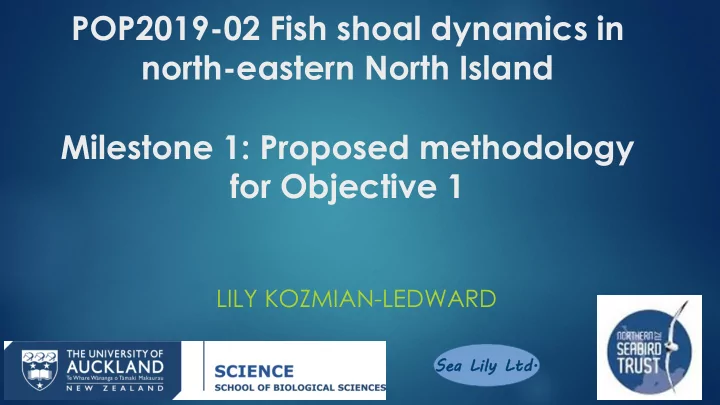

POP2019-02 Fish shoal dynamics in north-eastern North Island Milestone 1: Proposed methodology for Objective 1 LILY KOZMIAN-LEDWARD Sea Lil ily L Ltd.
POP2019-02: Objective 1 Identify zooplankton and other prey foraged by different fish shoal species and compare with previous data to better understand how interspecific differences in temporal and spatial fish shoal foraging affects dietary requirements of seabird populations. Follows on from previous years research. Research aims for 2019 - 2020: Determine the mechanisms that drive the occurrence of fish shoaling activity that is frequently associated with specific pelagic fish species Determine the nature of the link between fish shoaling activity and seabird feeding
Methods overview FIELD WORK LAB WORK Gannets, shearwaters & terns Seabirds – top predators Diet samples Prey items feed directly on – feed in association with collected in identified small to medium fish fish shoals/workups colonies Multiple species feed on Samples counted krill/zooplankton that Zooplankton into groups. the fish feed on sampling with nets Energy & volume Zooplankton measurements Topside Seabird abundance observations & & species identified photography Fish shoals – different Fish species species exhibit different Underwater identified & school behaviours and activity observations: behaviour studied videography Prey items identified, Fish captured and counted & energy stomach samples content measured taken Environmental variables recorded
Study area
Topside observations GPS positions of sample collections. Workup movements and approx area. Fish activity occurring & species present if possible. Seabird species present and abundance estimates, feeding behaviour. Any other marine megafauna present e.g. marine mammals. High resolution photography of species composition, feeding behaviours and general activity around fish schools.
Zooplankton sampling & analysis Design and test a high speed zooplankton net with flow-meter and camera that will effectively capture both large and small zooplankton types. Conduct horizontal, surface zooplankton net tows within fish shoal workups and nearby areas without workups. Compare old and new net performance. Identify and count zooplankton into seven groups and calculate number of individuals per m3 water filtered by net. Measure settled volume of each sample (ml/m3). Record size ranges of zooplankton types. Remove & record any larval/juvenile fish & plastics present. Determine the energy content of potential zooplankton prey using bomb calorimeter.
Zooplankton groups (I) Copepoda Malacostraca ~1.3 – 18 mm ~0.5 – 4.0 mm Fish eggs Nauplii 0.7 – 1.4 mm < 0.5 mm
Zooplankton groups (II) ~1.5 – 13+ mm Appendicularia ~2.0 – 4.5 mm Thaliacea Other
Fish sampling & analysis Capture both small and large fish from workups using combination of net & lures. Record species and fish length. Remove stomach contents and a small muscle sample Quantify numerical abundance of zooplankton/prey groups. Record size ranges of prey types found. Determine energy content of fish flesh using bomb calorimeter.
Underwater videography Deploy the floating camera rig into fish shoals / workups. Determine fish species present and larger zooplankton such as krill. Estimate size ranges of fish and/or life stage. Record behaviour of species involved in the workup. Camera on net to record any avoidance behaviour of zooplankton.
Environmental parameters Recorded both inside and away from workups. Sea surface temperature & salinity with YSI multiprobe. Water clarity with secchi disc. Chlorophyll a via water samples analysed later in lab. Weather conditions. Bathymetry via GIS shapefile.
Data analysis Determine if/what differences there are between zooplankton abundance and composition samples inside and outside of workups. Paired t-tests or ANOVA. Determine selectivity of fish species for zooplankton prey by comparing relative abundance in stomach contents with zooplankton hauls, and comparing among fish species in individual workup events. Chi-square comparisons of relative proportions. Determine associations among the presence of zooplankton, fish species, feeding bird species and environmental parameters in workups. Chi-square comparisons, or non- parametric multivariate analysis using Primer-e or Permanova methods.
Added value Done footage of workups to determine size (m2), shape, movements. Analysis of seabird regurgitations to compare with previously collected samples and with zooplankton samples collected this year.
Thank you
Seabirds
Recommend
More recommend